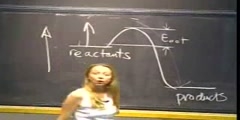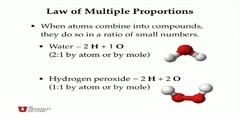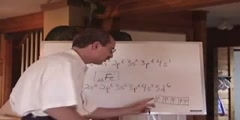Lec 20 - Rise of the Atomic Theory (1790-1805)
"Lec 20 - Rise of the Atomic Theory (1790-1805)" Freshman Organic Chemistry (CHEM 125) This lecture traces the development of elemental analysis as a technique for the determination of the composition of organic compounds beginning with Lavoisier's early combustion and fermentation experiments, which showed a new, if naïve, attitude toward handling experimental data. Dalton's atomic theory was consistent with the empirical laws of definite, equivalent, and multiple proportions. The basis of our current notation and of precise analysis was established by Berzelius, but confusion about atomic weight multiples, which could have been clarified early by the law of Avogadro and Gay-Lussac, would persist for more than half a century. 00:00 - Chapter 1. The Development of Elemental Analysis: Lavoisier's Early Combustion and Fermentation Experiments 12:24 - Chapter 2. The Correct Experiment: Early Dealings with Experimental Data 28:05 - Chapter 3. John Dalton's Proportions and Atomic Theory 37:28 - Chapter 4. Berzelius's Contributions to Modern Precise Analysis and the Atomic Weight Confusion Complete course materials are available at the Open Yale Courses website: http://open.yale.edu/courses This course was recorded in Fall 2008.
Video is embedded from external source so embedding is not available.
Video is embedded from external source so download is not available.
Channels: Chemistry (General)
Tags: Elemental Analysis Fermentation Lavoisier Berzelius Dalton Definite Proportions Equivalent Proportions and Multiple Proportions
Uploaded by: yalefreshorganic ( Send Message ) on 05-09-2012.
Duration: 50m 1s
Here is the next lecture for this course
Chemical Science-Atomic Theory of Matter ...
41:59 | 24361 viewsLec 94 - Writing Proportions
05:51 | 2362 viewsLec 49 - Comparing Population Proportions 1
10:47 | 2058 viewsLec 50 - Comparing Population Proportions 2
10:00 | 2020 viewsLec 51 - Hypothesis Test Comparing Popula ...
16:13 | 2807 viewsLec 100 - Understanding Proportions
01:25 | 2223 viewsLaws of Definate And Multiple Proportions
09:53 | 7459 viewsLec 21 - Berzelius to Liebig and Wöhler ...
49:22 | 2888 viewsJohn Dalton and the Atomic Theory
04:51 | 13210 viewsExplaining the Atomic Theory
04:45 | 3918 viewsAll About Atomic Theory
04:12 | 4258 viewsAtomic Theory
04:05 | 4571 viewsWhat is Atomic Theory
06:55 | 3919 viewsAP Chemistry - Atomic Theory 7
07:17 | 4386 viewsAnalysis of Absorption of Water By Atomic ...
00:57 | 6460 viewsNo content is added to this lecture.
This video is a part of a lecture series from of Yale
Lecture list for this course
Lec 2 - Force Laws, Lewis Structures and Resonance
Lec 3 - Double Minima, Earnshaw's Theorem and Plum-Puddings
Lec 4 - Coping with Smallness and Scanning Probe Microscopy
Lec 6 - Seeing Bonds by Electron Difference Density
Lec 7 - Quantum Mechanical Kinetic Energy
Lec 8 - One-Dimensional Wave Functions
Lec 9 - Chladni Figures and One-Electron Atoms
Lec 10 - Reality and the Orbital Approximation
Lec 11 - Orbital Correction and Plum-Pudding Molecules
Lec 12 - Overlap and Atom-Pair Bonds
Lec 13 - Overlap and Energy-Match
Lec 14 - Checking Hybridization Theory with XH_3
Lec 15 - Chemical Reactivity: SOMO, HOMO, and LUMO
Lec 16 - Recognizing Functional Groups
Lec 17 - Reaction Analogies and Carbonyl Reactivity
Lec 18 - Amide, Carboxylic Acid and Alkyl Lithium
Lec 19 - Oxygen and the Chemical Revolution (Beginning to 1789)
Lec 21 - Berzelius to Liebig and Wöhler (1805-1832)
Lec 22 - Radical and Type Theories (1832-1850)
Lec 23 - Valence Theory and Constitutional Structure (1858)
Lec 24 - Determining Chemical Structure by Isomer Counting (1869)
Lec 25 - Models in 3D Space (1869-1877); Optical Isomers
Lec 26 - Van't Hoff's Tetrahedral Carbon and Chirality
Lec 27 - Communicating Molecular Structure in Diagrams and Words
Lec 28 - Stereochemical Nomenclature; Racemization and Resolution
Lec 29 - Preparing Single Enantiomers and the Mechanism of Optical Rotation
Lec 30 - Esomeprazole as an Example of Drug Testing and Usage
Lec 31 - Preparing Single Enantiomers and Conformational Energy
Lec 32 - Stereotopicity and Baeyer Strain Theory
Lec 33 - Conformational Energy and Molecular Mechanics
Lec 34 - Sharpless Oxidation Catalysts and the Conformation of Cycloalkanes
Lec 35 - Understanding Molecular Structure and Energy through Standard Bonds
Lec 36 - Bond Energies, the Boltzmann Factor and Entropy
Lec Last - Potential Energy Surfaces, Transition State Theory and Reaction Mechanism















